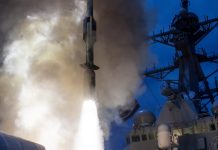A US Air Force C-17 Globemaster aircraft made a ‘gear-up’ landing in Afghanistan a week ago on October 18th. The plane had to undertake emergency landing when its nose gear failed to operate, according to reports.
The aircraft landed at Kandahar airfield, with its nose wheel up, however, no serious loss of life or property was reported.
“A U.S. Air Force C-17 Globemaster made an emergency landing at Kandahar Airfield this morning. No injuries have been reported and the airfield is open only to military traffic. Enemy activity was not involved.
The incident is under investigation,” tweeted the Army Col. Sonny Leggett, spokesperson for the U.S. Forces in Afghanistan.
A U.S. Air Force C-17 Globemaster made an emergency landing at Kandahar Airfield this morning. No injuries have been reported and the airfield is open only to military traffic. Enemy activity was not involved. The incident is under investigation.
— USFOR-A Spokesman Col Sonny Leggett (@USFOR_A) October 18, 2020
A video was posted online on Monday, showing the incident, with the landing gear doors open but the wheels apparently failing to lower.
The video was reportedly taken from a car driving along the runway and shows the aircraft land on its main landing gear which then slides down the runway as the nose gradually came down, with sparks coming out as the fuselage drags in through the ground.
The plane belongs to the 446th/62d Airlift Wing from Joint Base Lewis-McChord, Washington.
This is not the first time a C-17 performs a gear-up landing in Afghanistan. In 2009, Globemaster #96-0002, assigned to Charleston AFB, South Carolina, made a somewhat famous “gear up” landing at Bagram in Afghanistan.
Japanese F35s, US Navy Display Their ‘Muscle Power’ Amid Chinese Belligerence In The Indo-Pacific
The aircraft landed on the runway centerline with the landing gear retracted and slid approximately 4,500 feet before coming to rest on the runway. Crash, fire and rescue response was immediate, the crew escaped the aircraft safely and the emergency resulted in the temporary closure of the runway, but the C-17 was extensively damaged.
The Accident Investigation Board concluded the primary cause of the mishap was the failure of the pilots to lower the landing gear and confirm proper aircraft landing configuration in accordance with the Before Landing checklist, Aviationist reported.





